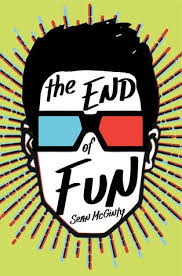
“FUN—the latest in augmented reality—is fun <yay!> but it’s also frustrating, glitch, and dangerously addictive <boo!>,” so everyone should put down his or her personal electronic devices and rejoin the “real” world. Sean McGinty’s The End of Fun, which will be published April 2016, opens with main character Aaron telling his readers that to terminate his contract with FUN he must earn 100 YAY!s first, so he recounts the past year of his life in 100 quick-to-read chapters. Comparisons to M. T. Anderson’s Feed are inevitable, but while Feed had a dark foreboding dystopian tone, The End of Fun is a light-hearted romp through desert of Nevada. Just as Aaron’s story starts to drag, a treasure hunt is added that livens up the romp. The brief description of what people look like while using FUN adds some humor that could have been expanded, especially if McGinty wants to convince teens that they look silly staring at any event through a 3-inch screen rather than watching it directly with their own two eyes. The possible environmental effect of FUN, which implies that we don’t know what problems we could be creating with our current technology, hits home, but, again, maybe not enough to convince teens to unplug. However, kudos to Hyperion/Disney Book Group for publishing a book that is for 14-18 year olds (due to drug/alcohol use and sexual content).
I received this book as an ARC at NCTE 2015. I was excited to see Disney (through Hyperion) publishing books for teens. At previous NCTE and ILA conventions that I’ve attended, Disney has promoted mostly middle level novels. I wanted to read this book over winter break because it had all the right words on the back blurb to interest me, and more importantly, to be a book that I can recommend to my students who prefer their gaming and electronics to my novels. And while I will add this to the short list of novels that cover those topics, this book is not at top of my recommend list.
It is very possible that The End of Fun pales in comparison to the novel that I just finished, Where Futures End. Both books imply that our electronic usage will have an unforeseen environmental effect in addition to the personal negative impact. However, Where Futures End is a much more sophisticated book. The fun style (word choice intended) of McGinty’s book would be more appealing to 8th/9th/10 graders, but the mature content is more appropriate for 10th/11th/12th graders. And McGinty’s structure beats you over the head with “electronics are not fun” on page one through page 405. His message is not a mystery.
I actually considered abandoning the book (which I always encourage my students to do when they would rather eat broken glass than read another word) around chapter 40 because I didn’t care what was happening to Aaron, and I was confident that after chapter 100 he would be able to terminate FUN. But, an old-fashioned treasure hunt to find Grandpa’s missing money was introduced to liven up the tale. Once again, by the end I didn’t care how Aaron’s life turned out; he terminated FUN, and we should all just have fun in real life. Got it.
